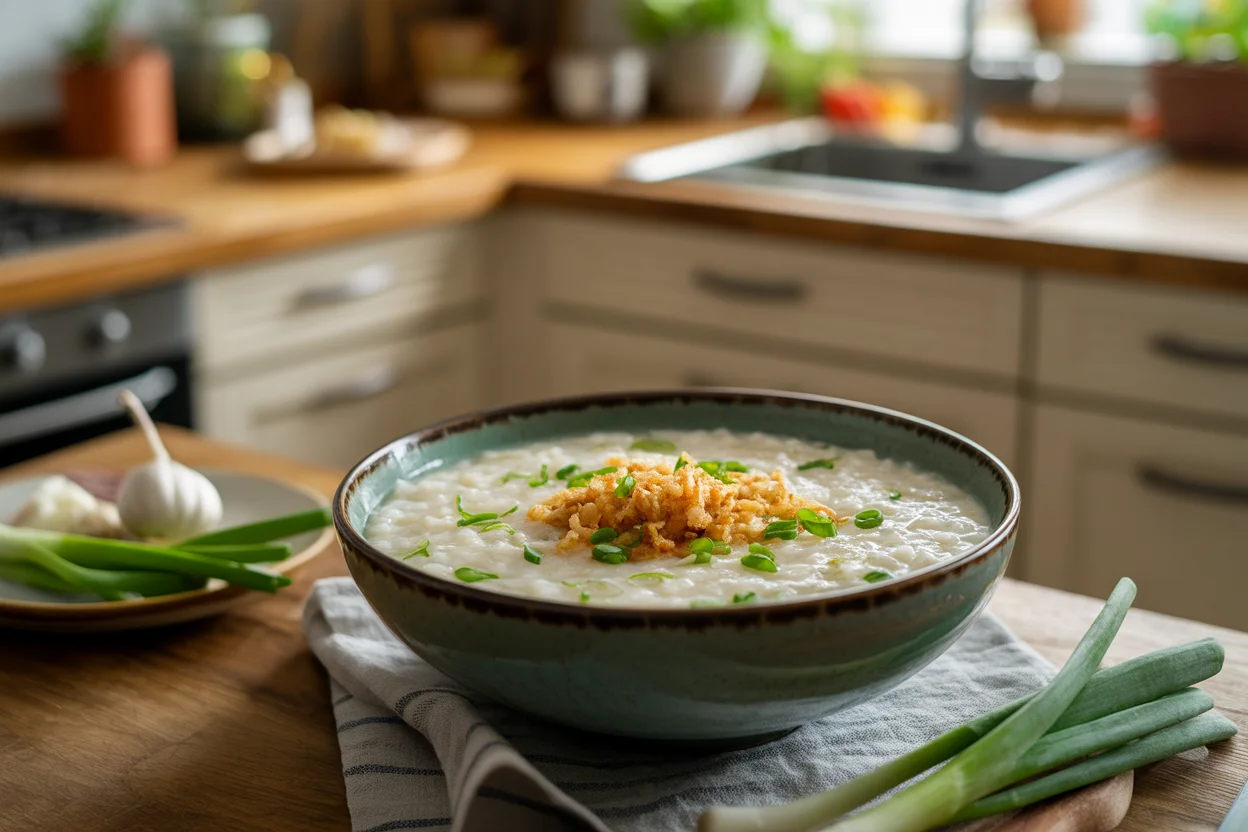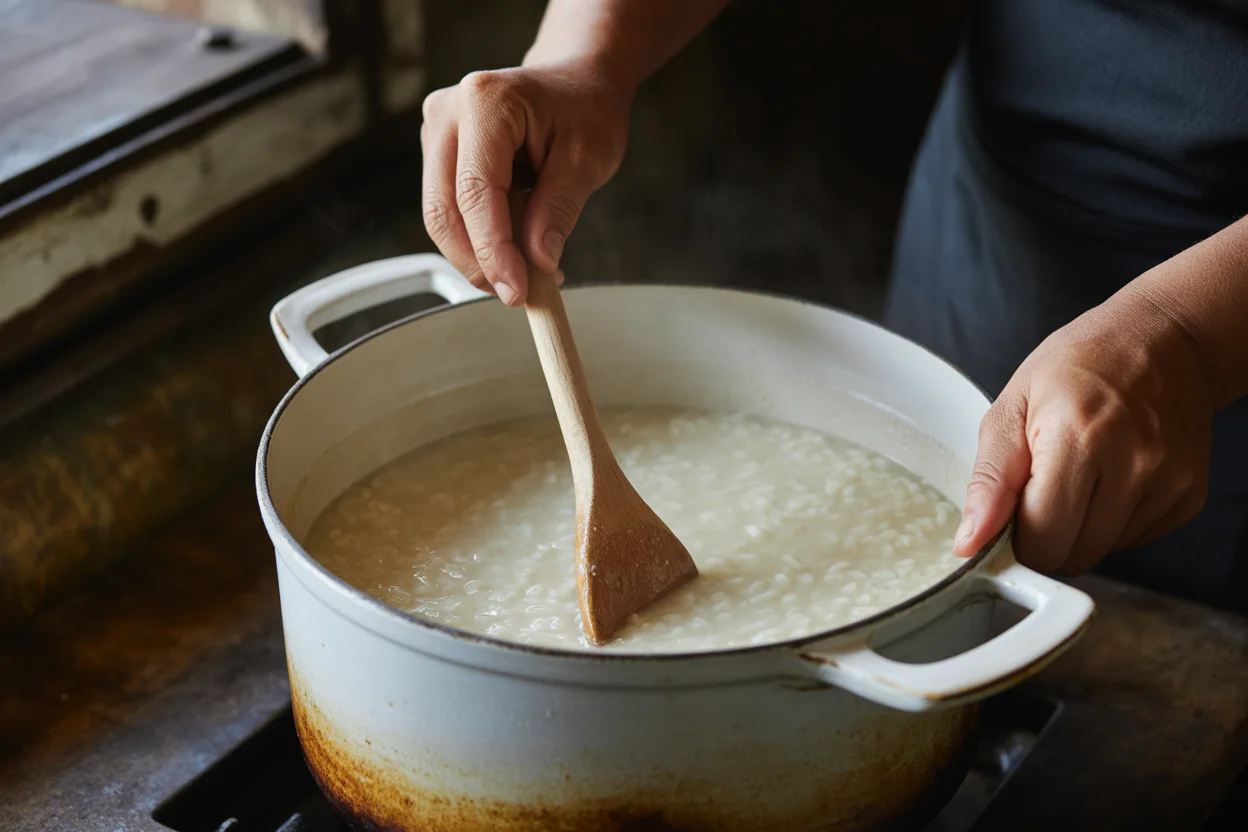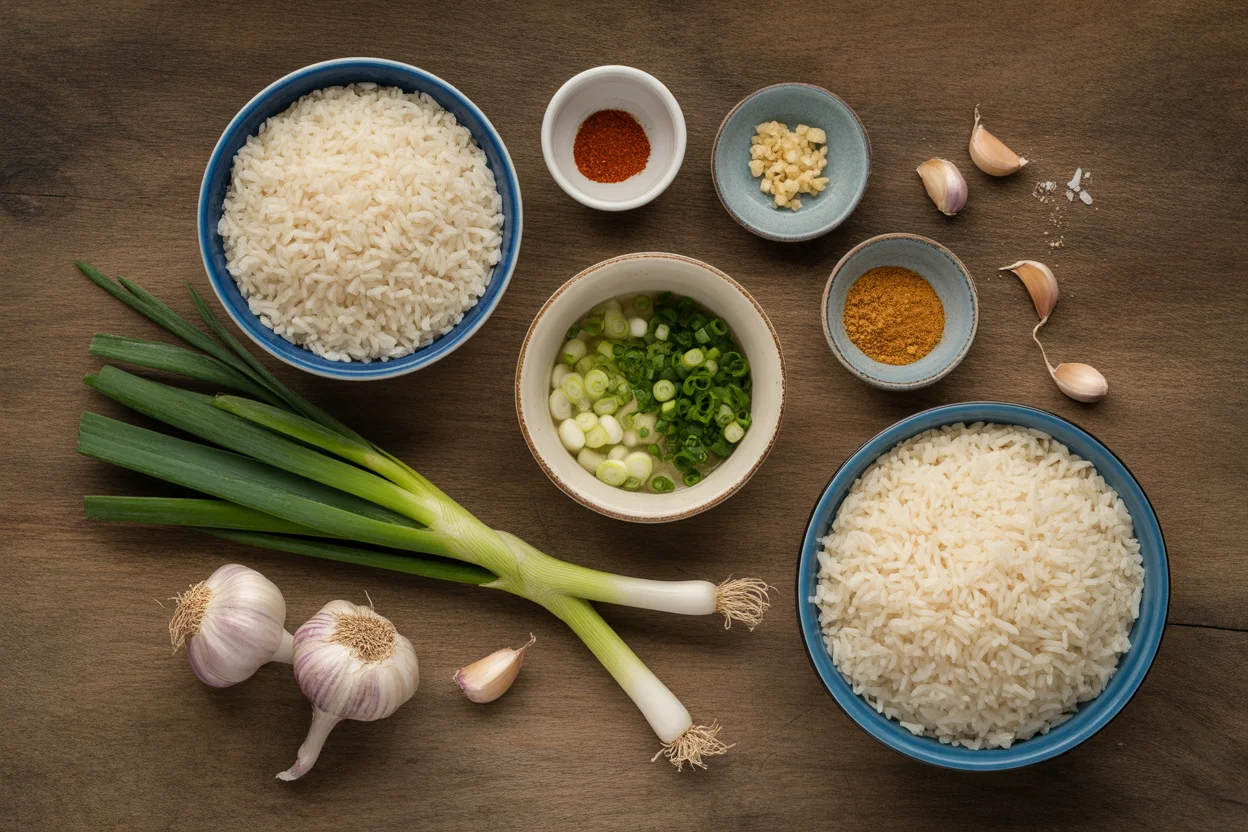- Overview of goto
- Preparing rice
- Cooking tripe
- Making broth
- Serving hot with egg
- Garnishes
- Comfort dish notes
- Common Questions
- Ready for Your Own Bowl of Goto?
So, Filipino goto recipe, huh? I bet you’ve been there—cold, rainy day, maybe even feeling a little off, and suddenly you’re craving something warm that just “sticks to your ribs,” as my Lola would say. That’s when I always think of goto. Trust me, learning how to make this comforting beef tripe rice porridge at home is way easier than it looks. It doesn’t take a culinary degree. Just heart, patience, and, well, a hangry family to feed. You want the classic flavors? Here’s a super-detailed blueprint, with some shortcuts and personal oops moments too. By the way, here are links if you want the original classic Filipino goto beef tripe rice porridge recipe or if you’re thinking about kid-friendly Filipino recipes because, let’s face it, picky eaters have opinions!

Overview of goto
Okay, so let’s talk about what goto really is before we dive into bubbling pots. Goto is basically Filipino beef tripe rice porridge. It’s got that thick, hearty feel—like a hug in a bowl, not kidding. Filipinos love eating it for breakfast, lunch, or really any time a rainstorm tries to cancel your day. Unlike other rice porridges, goto’s loaded with chewy beef tripe, which is honestly for the people who like their food a little adventurous. The beef tripe gives it that “I worked for this meal” bite.
What’s extra great? Goto is a team player at backyard parties or solo Netflix nights. Some families argue about whose version is the best—“put more ginger!” or “you need extra toasted garlic!” It’s always personalized. Kids sometimes act suspicious of the tripe, but a little pro trick: call it magic noodles. Boom—they’ll eat it up. If you want to see some legit variations, take a peek at this goto Filipino beef tripe rice porridge guide.

“Never thought I’d crave beef tripe, but goto is next-level comfort food. My grandma’s tip? Toast way more garlic than you think you’ll need.” – Anna, Manila
Preparing rice
This part’s simple but kinda sneaky if you don’t pay attention—rice makes or breaks your goto, seriously. Use ordinary white rice, preferably not the fancy scented kind. Wash it a couple times until the water runs clear, so you don’t end up with a mushy mush (ew). You’re after that perfect middle ground—soft grains that haven’t disappeared into glue. I once tried skipping the rinse. Do not recommend, unless you like porridge that looks like paste.
Some use leftover rice for a quicker cook, but fresh raw grains give the softest texture. My tip? Toast the rice in a dry pan for a minute if you want a nuttier finish. Not a requirement, but if you have extra time, why not? Just don’t burn it—learned that the smoky way. The rice will soak up all those broth flavors and kinda do magic, thickening up the soup and cuddling the tripe.

Cooking tripe
Alrighty, beef tripe can be, let’s say, an acquired taste, but treating it right makes all the difference. You’ve gotta clean it well, no skipping that. I scrub mine with salt and a bit of vinegar, then rinse with loads of water. Trim off any rough patches—nobody likes chewy bits that taste weird.
Boil your tripe until it’s tender, which honestly could take around 1-2 hours. I know that’s a commitment, but trust me, nobody likes jaw workout goto. If you’ve got a pressure cooker, it’s a life-saver, cutting time to about 40 minutes. Once it’s fork-tender, chop it into bite-sized pieces—not too small, not too big, or everyone’s just chasing tripe nubs around their bowl.
My uncle swears that a chunkier cut means more chew, which is true. But hey, you do you! The cooking time might feel long, but that slow simmering turns tough tripe into something cozy. And your kitchen? Gonna smell like a five-star restaurant by now.
Making broth
Here’s where the flavor party truly starts. I usually simmer beef bones, sometimes adding a bit of brisket for extra oomph. Throw in garlic, ginger, onion—be generous, this is the foundation. Slow cook the broth so all those flavors hang out and get mellow. Don’t rush or just dump a bouillon cube in and call it a day. That shortcut? Meh, it’s never as good.
Some recipes say to sauté the aromatics first, which boosts the flavor, so I always do it that way. When the broth’s ready, I add in the tender tripe and let the whole thing simmer together. The broth picks up that savory depth from tripe, beef, and rice, all at once. Sometimes I’ll fish out the ginger piece before serving because nobody wants that surprise zing while slurping. Add a pinch of salt and pepper to taste at the end. Just go by gut feel, not math.
<table_seo>
Serving hot with egg
This is the finishing moment, maybe even my favorite part. Ladle that bubbling hot goto into bowls while it’s still steaming. Now, here’s the thing—crack a fresh egg on top, right in the hot porridge. I’m telling you, the egg cooks in the heat and gets all silky. Some folks like mixing it in completely, others leave it half-runny for drama. Up to you, though.
If I’m feeling extra, sometimes I throw in a salted egg instead. Don’t skip the egg if you can help it—the creamy yolk against the savory broth is chef’s kiss. And don’t forget, goto is not shy with portions. It’s generous and meant for second helpings, so make more than you think you need.
Garnishes
Alright, here’s your “wow” factor part. Goto’s classic finish in our family is always heavy on garnishes. You want some of that toasted garlic, a zing of chopped green onions, maybe even crispy shallots if you’re after points with your titas. If you have calamansi, squeeze some on top for brightness. Lemon works too, in a pinch, but don’t let any lola catch you replacing calamansi on purpose.
Here’s what I pile on:
- Toasted garlic for crunch—that stuff goes fast!
- Fresh green onions for color and a little bite.
- Chicharron (crispy pork skin) for smoky, salty goodness.
Sometimes a dash of fish sauce (patis) too if the broth needs a pick-me-up. Okay, and sometimes, for the spicy crew, I’ll add a slice of red chili. Just don’t sneak that onto grandma’s bowl unless you wanna see someone do the “too spicy!” dance.
Comfort dish notes
There’s a reason goto’s survived across generations and “diet” trends—it’s a memory in a bowl. For Filipinos, it’s the go-to for after-midnight munchies, rainy season blues, or those stubborn colds that don’t want to leave. You can make a batch big enough for the whole barangay, and the leftovers only get better overnight.
Plus, goto fits right in alongside other cozy faves, like hearty Filipino beef caldereta or Filipino grilled pork BBQ. Bring it to family gatherings, and be prepared for recipe requests (and judgment if you serve it bland, haha). Ultimately, goto is simple—honestly, just rice, beef tripe, broth, egg, and love. Not fancy, just true blue comfort.
Common Questions
Does beef tripe have to be cleaned before cooking goto?
Absolutely, yes. Not cleaning tripe can ruin the dish with weird flavors and textures. Trust me—don’t skip this. Grab the salt and vinegar.
Can I use other proteins instead of tripe?
For sure! Some people swap in beef shank or even pork. But then it’s not really “goto,” you know? Still tasty, though.
How do I keep my goto from being too thick or too thin?
Add more water if it’s getting gluey or simmer it longer if it’s too watery. Rice is pretty forgiving, just keep stirring until it feels right.
Is goto healthy?
Well, it’s not “diet food,” but it gives you protein and energy. For lighter versions, you can skim off excess fat. Or if you’re curious, check this healthy Filipino recipes collection.
What’s the best way to reheat leftover goto?
Just add water or broth and heat slowly on the stove. Microwave works in a pinch, but leftovers will need extra liquid.
Ready for Your Own Bowl of Goto?
There you have it—my personal take (sometimes a little chaotic) on making Filipino goto recipe at home. The steps aren’t too fancy, but they are packed with love and a little patience. Whether you stick with the classic version or add your own spin, this Filipino beef tripe rice porridge might just become your rainy day best friend. If I were you, I’d get started now and see why so many Filipino families call this their “cure-all.” If you want more takes or step-by-step, there’s this Goto Recipe idea or even Foxy Folksy’s Goto Recipe(Beef Tripe Rice Porridge), both are worth peeking at!
Now, send me pics when you try it. Or better yet, invite me over. I’ll bring the fried garlic!

Goto
Ingredients
For the rice
- 1 cup ordinary white rice Wash until water runs clear; optional to toast in a pan for a nuttier flavor.
For the tripe
- 1 lb beef tripe Clean thoroughly with salt and vinegar, boil until tender (1-2 hours) or use a pressure cooker.
For the broth
- 4 cups water Used to simmer beef bones and tripe.
- 2 pieces beef bones Simmer for rich flavor.
- 1 piece onion Chopped, added for flavor.
- 2 cloves garlic Smashed, added for flavor.
- 1 inch ginger Sliced, added for flavor.
- to taste salt Adjust at the end of cooking.
- to taste black pepper Adjust at the end of cooking.
For serving
- 1 large egg Crack on top of the hot goto to cook in the heat.
- 1/4 cup toasted garlic For garnish.
- 1/4 cup chopped green onions For garnish.
- 1/4 cup chicharron For garnish, optional.
- to taste calamansi or lemon For squeezing on top.
Instructions
Preparation
- Wash the rice until the water runs clear to avoid mushy consistency.
- Optional: Toast the rice in a dry pan for a nuttier flavor.
- Clean the beef tripe with salt and vinegar, then rinse thoroughly.
Cooking Tripe
- Boil the tripe in water until tender, approximately 1-2 hours, or 40 minutes in a pressure cooker.
- Chop the tripe into bite-sized pieces once tender.
Making Broth
- Simmer beef bones in water, adding chopped onion, smashed garlic, and sliced ginger.
- Cook the broth slowly to enhance flavors. Avoid shortcuts like bouillon cubes.
- After the broth is ready, add the cooked tripe and allow to simmer together.
Serving
- Ladle the hot goto into bowls and crack a fresh egg on top.
- Garnish with toasted garlic, chopped green onions, chicharron, and calamansi.

